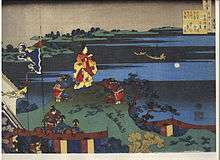Abe no Nakamaro
Abe no Nakamaro (阿倍 仲麻呂, c. 698 – c. 770), whose Chinese name was Chao Heng (Chinese: 晁衡, pronounced Chōkō in Japanese), was a Japanese scholar and waka poet of the Nara period. He served on a Japanese envoy to Tang dynasty China and served as the Tang jiedushi (governor) of Annam (modern Vietnam).[1]

Early life
He was a descendant of Prince Hikofutsuoshi Makoto, the son of Emperor Kōgen and first son of Abe no Funamori. As a young man he was admired for having outstanding academic skills.
Career
In 717-718, he was part of the Japanese mission to Tang China (Kentōshi) along with Kibi no Makibi[2] and Genbō.[3] They returned to Japan; he did not.
In China, he passed the civil-service examination. Around 725, he took an administrative position and was promoted in Luoyang in 728 and 731. Around 733 he received Tajihi Hironari, who would command the Japanese diplomatic mission. In 734 he tried to return to Japan but the ship to take him back sank not long into the journey, forcing him to remain in China for several more years. In 752, he tried again to return, with the mission to China led by Fujiwara no Kiyokawa, but the ship he was traveling in was wrecked and ran aground off the coast of Vietnam, but he managed to return to Chang'an in 755.
When the An Lushan Rebellion started later that year, it was unsafe to return to Japan and Nakamaro abandoned his hopes of returning to his homeland. He took several government offices and rose to the position of Governor-General of Annam between 761 and 767, residing in Hanoi. He then returned to Chang'an and was planning his return to Japan when he died in 770 at age 72.
He was a close friend of the Chinese poets Li Bai and Wang Wei, Zhao Hua, Bao Xin, and Chu Guangxi.[1]
Legacy

From his literary work he is most famous for a poem filled with intense longing for his home in Nara. One of his poems was included in the anthology Hyakunin Isshu[4] and in the Kokin Wakashū.
| Japanese text | Romanized Japanese | English translation[5] |
|
|
|
- — Kokin Wakashū 9:406
Abe's place in Japanese cultural history is confirmed in Hokusai's Hyakunin Isshu series of ukiyo-e woodblock prints.[6]
References
- Nussbaum, Louis-Frédéric. (2005). "Abe no Nakamaro, "Japan Encyclopedia, p. 3.
- Nussbaum, "Kibi no Makibi" at p. 512.
- Nussbaum, "Gembō" at p. 235.
- Mostow, Joshua S. Pictures of the heart: the Hyakunin isshu in word and image, pp. 161-164.
- McMillan 2010, p.7
- Machotka, Ewa. (2009). Visual Genesis of Japanese National Identity: Hokusai's 'Hyakunin Isshu', pp. 92-95/
Bibliography
- McMillan, Peter (2010). One Hundred Poets, One Poem Each: A Translation of the Ogura Hyakunin Isshu. New York: Columbia University Press. ISBN 9780231143998.
External links
![]()